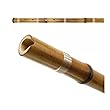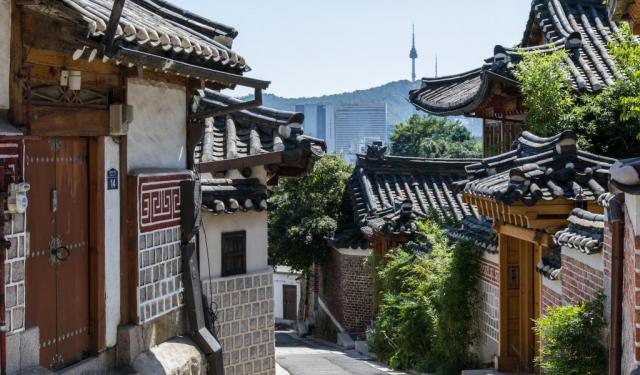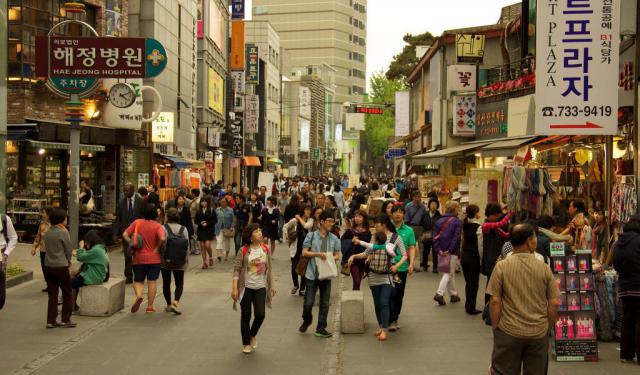1. Korean Celadon Buddhist Incense Burner
Called hoon-ro in Korean, incense burners have been used in Korea since ancient times to remove bad smells and disperse negativity. The reason most censers in Korea are associated with Buddhism is because Buddhism was introduced to the country more than 1600 years ago and was a dominant religion here until Christianity gained a strong following in recent decades. Buddhists believe that just as burning incense removes unpleasant odors, it also cleanses human body and mind. Pursuant to this belief, incense burning forms part of many Korean ancestral rites and ceremonies, as well as funerals. These incense burners are truly exquisite and uniquely Korean. Every burner is hand-crafted and made with the finest celadon available. Traditionally, most burners feature local animals, such as turtles, rabbits, cranes, and tigers, as well as plants - lotus or chrysanthemum.
Where to find it:
National Souvenir Center
Business hours: Monday-Friday: 10 a.m. - 6 p.m.;
Saturday: 11 a.m. - 6 p.m.
Address: 14 Insa-dong, Jongno-gu, Seoul
Price range: 12,000 –80,000 won for 1 burner, depending on size
Buy It on Amazon:
Offline reading and travel directions:
With GPSmyCity App you can read this article offline on your mobile device, use the embedded offline city map and GPS navigation, as well as create a self-guided walk to visit the venues featured in the article.
2. Traditional Korean Masks
Called tal in Korean, Korean masks have a long tradition of being used in ceremonies and rituals, as part of battle uniforms, and in royal courts. Due to Korea’s shamanistic beliefs, grotesque and gruesome masks had much ceremonial use to drive away evil spirits and usually elicited responses, such as fear or laughter, in audience. Battle masks were often worn by soldiers and their horses. Folk masks — called hahoe-tal — were often used in dances and plays. These days, masks are mostly used as good-luck talismans and in the reenactments of traditional ceremonies and plays. Masks are usually made of alder wood, lacquered to render them waterproof, and painted with designs. One can usually tell if a mask is meant to represent a male or female by check out red dots on the forehead and cheeks. Those with the red dots are almost always female, while the ones without them are usually male.
Where to find it:
National Souvenir Center
Business hours: Monday-Friday: 10 a.m. - 6 p.m.;
Saturday: 11 a.m. - 6 p.m.
Address: 14 Insa-dong, Jongno-gu, Seoul
Price range: 40,000 – 60,000 won per mask
Buy It on Amazon:
Offline reading and travel directions:
With GPSmyCity App you can read this article offline on your mobile device, use the embedded offline city map and GPS navigation, as well as create a self-guided walk to visit the venues featured in the article.
3. Korean Hanbok Dolls/Teddies

Hanbok is the traditional Korean dress that used to be worn by both, males and females, before Korea’s westernization. The full attire can be divided into vests, pants and dresses, and tops. The upper garment is called jeogori in Korean, and was worn by both, men and women. They are usually long-sleeved and have a band that trims the collar. The jeogori is often held in place with ribbons or string. For bottoms, men would wear baji, which are trousers, whereas women would wear chima, the Korean word for “dress.” Women usually wore an underskirt called the sokchima beneath the chima. Vests or jackets would often be worn over the jeogori to keep warm and to add to one’s style. Men of higher standing would often wear hats made from horse hair, called gats in Korean. Instead of the actual full-scale hanbok, one can buy Korean hanbok dolls and teddies. These can be perfect decorations to keep at home and show off to visitors. Young girls will love these dolls in particular!
Where to find it:
National Souvenir Center
Business hours: Monday-Friday: 10 a.m. - 6 p.m.;
Saturday: 11 a.m. - 6 p.m.
Address: 14 Insa-dong, Jongno-gu, Seoul
Price range: 15,000 – 30,000 won for 1 doll/teddy
Buy It on Amazon:
Offline reading and travel directions:
With GPSmyCity App you can read this article offline on your mobile device, use the embedded offline city map and GPS navigation, as well as create a self-guided walk to visit the venues featured in the article.
4. Korean Celadon Chinaware
Known locally as cheong-ja, Korean celadon is famous for being beautiful and of high quality. Korean pottery has a long history, dating back thousands of years. Korean pottery differs from Chinese in a sense that it is more about simplicity in design, rather than overt fanciness. Korean celadon artisans liked to contrast colors by using an overlaying glaze that was different from the clay body. Inlaying designs, called sang-gam in Korean, was a technique where differently colored clay would be used to produce a single celadon, which would sport multiple colors. Celadon refers to the jade-green glaze commonly seen in Korean pottery. Korean celadon is sometimes called “Goryeo celadon” because it was developed and refined during the Goryeo period in the 10th and 11th centuries. One can get beautiful celadon chinaware at decent prices at many porcelain shops in Insa-dong.
Where to find it:
National Souvenir Center
Business hours: Monday-Friday: 10 a.m. - 6 p.m.;
Saturday: 11 a.m. - 6 p.m.
Address: 14 Insa-dong, Jongno-gu, Seoul
Price range: 40,000 – 80,000 won for 1 tea set with pot and cups
Buy It on Amazon:
5. Specialty Organic Korean Jakseol Green Tea (Jakseolcha)

Koreans love their coffee and tea. Most Koreans drink at least a cup of tea every day. One of the finest Korean green teas is known as the “sparrow’s tongue” because the tea leaf looks exactly like it. While jakseolcha comes from the same variety of tea tree as regular green tea, it is set apart because only the young buds of the leaves are used. It is these buds that are said to look like a sparrow’s tongue, and they are usually harvested on Kogu — one of the 24 seasonal divisions used in Korea — which is around April 20. Unsurprisingly, jakseolcha is the most expensive type of green tea in Korea. The proper way to prepare jakseolcha is by adding tea leaves to hot water (70–80°C) and letting them soak for several minutes before consumption. Care must be taken to ensure the proper ratio of water and tea leaves. One should add more hot water, after finishing the first cup, to drink multiple cups with the same leaves. It is said the flavor is even better in the second and third cups. Jakseolcha comes in a nice box with a tea set. A must-have gift for true tea lovers!
Where to find it:
Any Hyundai Department Store
Business hours: 10:30 a.m. – 8:00 p.m.
Address: 455-8 Cheonho-dong, Gangdong-gu, Seoul (Cheonho branch)
Price range: 50,000 won for 60g of Jakseol green tea
Buy It on Amazon:
6. Korean Paper (Hanji)

Hanji is a Korean tradition that is over a thousand years old. Traditional handmade paper from Korea used to be widely regarded as one of the best papers in East Asia. Hanji was known for its strength, aesthetics, and luster. Due to its durability and insulating capabilities, hanji was used to cover most of the walls, doors, and windows in traditional Korean houses. It is made from the bark of the paper mulberry tree and is still used for calligraphy and artistic purposes. One of the best-known documents in Buddhism, called Jikji, was printed in 1377 with metal movable type on hanji. Hanji was widely used until Western mass production printing methods were introduced in Korea in the late 1800s. As there are only roughly a couple of dozen hanji paper mills left in Korea, the amount of hanji paper made every year is limited. Hanji can come in a variety of colors, depending on the dye added during the paper-making process. A unique way to send a letter to a close friend or relative would be to write it on a sheet of hanji paper, and then mail it in a hanji envelope.
7. Traditional Korean Silk (or Hanji) Folding Fan

Traditional Korean fans, much like hanji, were highly regarded in East Asia and beyond for their superior quality and beauty. The folding fan is widely believed by Korean art historians as having been invented by a Buddhist monk during the Goryeo period. Known locally as buchae, fans were an essential carrying item, even in winter, for many Koreans. Although the typical use of a fan was to cool one’s own body from the heat, there were many other uses to it as well, including: providing shade from the sun, hiding one’s face from onlookers, as a weapon of war, as well as being one of the main props in traditional Korean performances and dances. The bottom holding parts of these fans are made from bamboo, whereas the top parts are made either from hanji or silk. These handcrafted fans can be folded for easy portability and feature traditional Korean designs. The latter are quite a few to choose from: from simple water lily designs to the ones with Korean writing and painted images of traditional local animals, such as tigers and cranes.
Where to find it:
Urisegae
Business hours: 10:00 a.m. – 8:30 p.m.
Address: 15 Insa-dong, Jongno-gu, Seoul
Price range: 10,000 – 30,000 won per fan
Buy It on Amazon:
8. Traditional Korean Ornate (Mother of Pearl) Jewelry Box
Called boseok-ham in Korean, jewelry boxes are widely used in Korean homes. Most of them are black and adorned with designs featuring traditional Korean animals, such as tigers and cranes, as well as picturesque mountain views and lake scenery. The outside is usually made from mother of pearl (nacre), whilst the inside usually has soft, velvet-colored padding over a wooden frame. The boxes also have a clasp to keep it shut. Mother of pearl is an iridescent material that comes from certain species of mollusks. These mother of pearl jewelry boxes will reflect different colors of light at different viewing angles due to their iridescent properties. Being made from nacre, these boxes are very strong and resilient. Such jewelry boxes make a great gift to any female relative, friend or acquaintance who would like to keep her jewelry in a beautiful, ornate storing box.
Where to find it:
Where to buy: Gyeongil Hanji Department Store
Business hours: 10:00 a.m. – 9:00 p.m.
Address: 179-2 Insa-dong, Jongno-gu, Seoul
Price range: 60,000 – 100,000 won per box
Buy It on Amazon:
9. Traditional Korean Silk Coin Purse
Coin purses have been used by women since the time Korean coinage was invented. Korean purses not only served a practical purpose—to store all of one’s coins for easy portability—they were also a great complimentary accessory to go along with traditional Korean dress, known as hanbok. Often, women would procure purses that matched or complemented their outfits. Nowadays, very few modern Korean women actually use these purses for anything other than aesthetic purposes in the home. However, they are still sometimes used in traditional Korean ceremonies. Many purses are handmade with Korean floral designs etched on them. There are many colors and designs to choose from. The silk is smooth to the touch. The top of the purse has a string so one can tie up the purse when needed. This gift would be perfect for a female relative, friend, or acquaintance back home who likes keeping their change in a fancy purse.
Where to find it:
Urisegae
Business hours: 10:00 a.m. – 8:30 p.m.
Address: 15 Insa-dong, Jongno-gu, Seoul
Price range: 10,000 – 20,000 won per purse
10. Korean Rice Cakes (Tteok)
Tteok is one of the most widely consumed foods in Korea. It is made by steaming glutinous rice flour. As there are over a hundred varieties of tteok out there, it will be very difficult to sample each and every one during one’s trip to Korea. Many kinds of rice cakes are sweet because of added red bean paste, mung bean paste, honey, or fruits. Other kinds of rice cakes are not sweet at all, but have a more savory flavor from added nuts, oil, or seeds. Because tteok is such an integral part of Korean culture, it is one of the foods always present on two of Korea’s biggest national holidays: New Year’s Day and Chuseok. A box of assorted Korean rice cakes can be a delicious snack to share with friends back home. There are many kinds of rice cakes, so one can even choose to stick with just the cakes one wants, after sampling a few at the store.
11. Hair Barrettes for Girls
Korean accessories are well-known as being flashy and appealing to the eye. Not only are these accessories very decorative, they are also very sturdy and well-made. It is very common to see young Korean girls and women wear hair barrettes to keep their long hair in place. They are also great at keeping hair out of the eyes. Barrettes come in a wide variety of colors and designs; many have little gems on them that glitter in the sunlight. The ones made with a plastic clip are often lighter than those with a metal clip. Barrettes range in size from just over an inch to over 5 inches long. As they are quite cheap and come in such a wide variety, one could purchase dozens of these and gift them to young females back home. They will really help bring out the feminine side of the woman who wears them.
Where to find it:
Gyeongil Hanji Department Store
Business hours: 10:00 a.m. – 9:00 p.m.
Address: 179-2 Insa-dong, Jongno-gu, Seoul
Price range: 3,000 – 20,000 won per barrette
Urisegae
Business hours: 10:00 a.m. – 8:30 p.m.
Address: 15 Insa-dong, Jongno-gu, Seoul
Price range: 3,000 – 20,000 won per barrette
Buy It on Amazon:
12. Premium Soju

Soju is one of the most famous and widely-consumed of Korean liquors. It is a clear liquor, like vodka, but is usually not as strong. Most soju varieties are anywhere from 18.5% to 25% alcohol by volume. Although soju was traditionally made from rice, the Korean government prohibited the use of rice in soju distillation from the mid 1960s until 1999 to help relieve rice shortages.
While the common, mass-produced soju found in restaurants and drinking establishments are made from cheaper ingredients such as tapioca, sweet potato, wheat, or barley, there are also many premium soju’s that are made from finer ingredients. It is recommended to pay a little extra to either enjoy traditional rice soju, ginseng soju, or soju that has been aged 10 years in oak barrels. While chilled soju is usually enjoyed neat in a soju shot glass, many soju cocktails have been developed to facilitate wider consumption. One can get a traditional celadon soju drinking set — complete with jar and shot glasses — to make the experience more authentic. These sets can be found in most large department stores, such as Hyundai Department Store, and range anywhere from 47,000 to 80,000 won.
Where to find it:
Any E-mart store
Business hours: 10:00 a.m. – 11:00 p.m.
Address: 454-1 Cheonho 2-dong, Gangdong-gu, Seoul (Cheonho branch)
Price range: 5,800 – 24,000 won for 1 bottle, depending on brand, type of soju, and volume
13. Wooden Spoon and Chopsticks Set
The spoon and chopsticks are the two most common eating utensils in Korea. Just 10 years ago, it was very difficult to find Korean restaurants that provided forks and knives to foreign diners who were not proficient at chopstick use. Nowadays, however, many non-Koreans are able to use chopsticks, as well as forks being more readily available at Korean restaurants. Traditional Korean meals would usually consist of a bowl of rice, a bowl of soup or stew, and various side dishes, where the soup and rice would be eaten with a spoon and the chopsticks used for the side dishes. While in most Korean homes the family would dine with metal eating utensils, a nice set of wooden eating utensils would be a great item to show friends and family what one ate with during one’s stay in Korea. Most of these sets come contain two spoons and two pairs of chopsticks, as well as a chopsticks holder to place the chopsticks on top.
Where to find it:
National Souvenir Center
Business hours: Monday-Friday: 10 a.m. - 6 p.m.;
Saturday: 11 a.m. - 6 p.m.
Address: 14 Insa-dong, Jongno-gu, Seoul
Price range: 30,000 – 40,000 won per set
Buy It on Amazon:
14. Traditional Korean Bamboo Flute

There is a saying in Korean regarding playing a flute, “When you play on the instrument, your enemies retreat, illness is cured, and the wind and sea are calmed.” It shows how much value and admiration Koreans place on musical instruments. Korean bamboo flutes come in 3 different sizes, each with its own Korean name. The largest, called daegum, is a transverse bamboo flute with a buzzing membrane. Next in size is the jung-gum, which is smaller than the daegum and also lacks a buzzing membrane. The smallest is called the sogeum and also lacks a buzzing membrane. The three are collectively known as samjuk, which means “three bamboo” in Korean. Bamboo flutes were used in traditional Korean ceremonies, rituals, courtly plays, as well as in folk music. They are still used in the modern music industry to provide film soundtracks, samples for contemporary music, and in contemporary classical music. The price depends on the size and number of finger-holes. Usually, the larger the flute, the higher the price.
Where to find it:
Samick Piano
Business hours: 10:00 a.m. – 8:00 p.m.
Address: 78-1 Insa-dong, Jongno-gu, Seoul
Buy It on Amazon:
15. Korean Paintings

Korean artwork has a distinct style with many artists choosing to display picturesque, tranquil sceneries of Korea’s majestic mountains and villages of old. It is useful to remember that Korean art was heavily influenced by Confucianist and Buddhist philosophies. This is why traditional artwork was limited in color and became known for its simplistic design. Commonly depicted animals include the Korean tiger, cranes, and cows. These animals are considered “Korean,” and their heavy portrayals represent the efforts of Korean artists to choose to paint subjects which they felt were distinctly Korean.
Other recurring images found in local art include: women swinging on a swing, women doing laundry at a stream, women getting water from a well, women playing nol-ttwigi on a see-saw, families playing yutnori (a Korean board game) out in the yard, farmers tending crops. Almost all Korean artists sign their works with their own personalized name stamp, as well with their names in Chinese characters. These paintings will add a unique, authentic Korean flavor to any home decorations. It is particularly recommended to get the paintings made on hanji, to heighten the authenticity.
Where to find it:
Back Jae Paper Shop
Business hours: 10:00 a.m. – 9:00 p.m.
Address: 190-1 Insa-dong, Jongno-gu, Seoul
Price range: 20,000 – 100,000 won per painting
Gyeongil Hanji Department Store
Business hours: 10:00 a.m. – 9:00 p.m.
Address: 179-2 Insa-dong, Jongno-gu, Seoul
Price range: 20,000 – 100,000 won per painting
Buy It on Amazon:
16. Traditional Korean Tobacco Smoking Pipe

While smoking pipes don’t have a thousand-year local tradition to them, like hanbok or bamboo flutes, they are nonetheless an important cultural item with over four hundred years of tradition, which also counts. Smoking was an important pastime not only for men, but also women and even children in Korea. The material of which the pipe was made depended on a person’s social status and wealth. The wealthy would often enjoy pipes layered with precious metals and stones, whereas commoners would have simple, wooden pipes. Interestingly enough, the wealthier one was, the longer their pipe would smoke. This was because the long pipes — some as long as four feet — could only be smoked with the aid of a servant who would light the pipe for the smoker. Hence, long, impractical pipes became a symbol of wealth and status. The ones sold in Insa-dong are made from a wooden shaft with a metal tip and bowl. The metal parts usually have Korean designs engraved on them. Some pipes come with a tassel. The price varies according to the length of the pipe.
Where to find it:
Insa Amethyst
Business hours: 10:00 a.m. – 8:00 p.m.
Address: 168 Insa-dong, Jongno-gu, Seoul
Price range: 3,000 – 10,000 won per pipe
17. Korean Ginseng

Korean ginseng is world-famous for its health benefits. It is said the highest-quality ginseng grows in Korea because of the country’s unique climate and geography. Ginseng is called insam ("person") in Korean because its shape is said to resemble a person. The roots can reach a length up to 60cm, and the cultivated roots are often harvested either at the 4- or 6-year mark.
Because the Korean ginseng market is so huge, there are multiple ways to classify all the different ginseng products that reach consumers. There are three ways to classify according to processing methods: susam, where the roots come as is; baeksam, where the roots’ skin is slightly peeled off and then sun-dried to 14% moisture content; hongsam or red ginseng, where the skin isn’t peeled and the roots are steamed. There are also three classifications according to cultivation methods: jaebaesam, where the plants are cultivated on a farm; jangnoesam, where seeds are purposefully planted deep in the mountains and left to grow naturally; sansam, the most expensive variety, where naturally grown ginseng is harvested in high mountains. Finally, the country of origin is also sometimes used for classification purposes. Korean-grown ginseng is sometimes called “Goryeo insam” to differentiate it from ginseng originated elsewhere.
Where to find it:
Any Hyundai Department Store
Business hours: 10:30 a.m. – 8:00 p.m.
Address: 455-8 Cheonho-dong, Gangdong-gu, Seoul (Cheonho branch)
Price range: 70,000 – 1,740,000 for a box of 600g of Korean ginseng
Buy It on Amazon:
Other Interesting Souvenirs from Korea
If traveling to Korea is not on your immediate agenda, or you simply can't afford an extra space in your luggage, fortunately, these days, you can find a wide selection of authentic and truly interesting Korean souvenirs online. Presented here are some of the Korean products sought by foreign visitors, now available online for your convenience.
1. Korean Skin-Care Products - Korean cosmetics are definitely on the list of beauty must-haves of many women around the world. Whether you need to revitalize your weary eyes, remove wrinkles, restore moisture balance in skin to make it soft and supple again, or to suppress dark spots and freckles, and to prevent hyper-pigmentation, Korean cosmetics, infused with bamboo and seawater extracts, have the working solutions for these and other problem areas. Just keep it in your bag, or somewhere at hand, during the day!



2. Dried Seaweed – Gim - Gim, the Korean analogue of Japanese “nori”, is the dried seaweed renowned for its taste and medicinal properties. Staple ingredient of the local cuisine, Gim is usually seasoned with nothing but salt and sesame oil, and is eaten either alone (roasted) or paired with some rice for more enjoyment. In the old Korean tradition, during Chuseok holiday (local Thanksgiving) and Lunar New Year, Gim is given as a gift together with fresh fruit. These days, it is also a popular souvenir that most visitors to Korea tend to bring home.



3. Korean Snacks - Traditional Yakgwa (sweet honey cookies waffles), Gosomi sweet cookie crackers (nutritious snacks for kids), rice snacks chips and many more make up the long list of popular snacks you may want to try from Korea. Good with wine and cheese or just by themselves, these products of Korea are savory, crispy, salty or sweet melt in your mouth, and will make a great Christmas or other holiday present.




4. Traditional Metal Bookmarks - Make your reading a bit more exciting with the help of Korean metal bookmarks depicting various traditional themes: temples, elegant Korean women, pine trees, cranes and many others, each with a special meaning. A fine piece of Korean culture, these extra thin bookmarks, made of durable metal, will last for decades and help save many books from creases. These cute Korean souvenirs will surely make a perfect gift for any person who loves to read, any bookstore, library, etc.



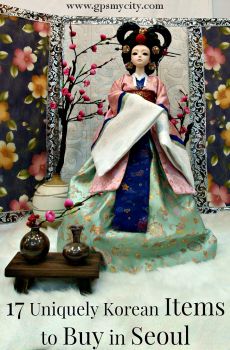
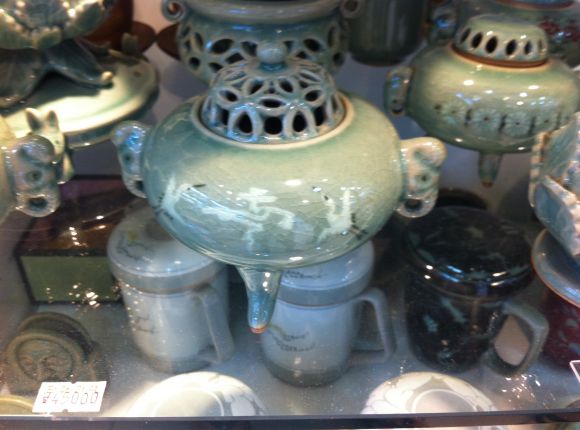



.jpg)
.jpg)
-folding-fan.jpg)
-jewelry-box.jpg)

.jpg)



































